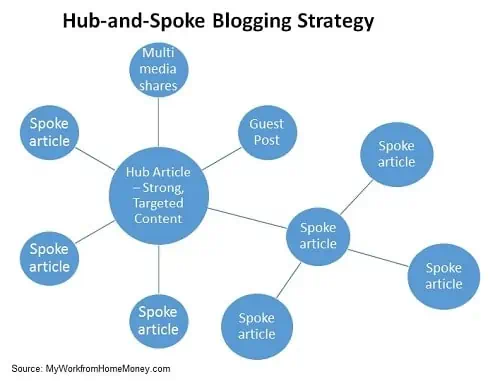Three reasons why internal linking is so important for SEO and how to use the hub-and-spoke strategy
So we know that links to your blog and posts are hugely important to getting found in search. Google has explicitly said that content and links are the two most important factors in its algorithm.
Even with killer content, links can be hard to come by. Each of the three best link-building strategies we covered in our prior post take a lot of time and even a little money in the case of a scholarship page.
So what’s a budding internet entrepreneur to do? Google search is half or more of most blogs’ traffic.
Do you wait years of the natural backlinks to develop or do you devote years to link-building strategies?
What if I told you one of the best sources for links is one you control?
This linking strategy not only tells Google that a post or page is important but it also helps the search engine find its way around your blog and index more pages.
It’s called internal linking and while most bloggers are already doing it…they aren’t necessarily doing it right.

Don’t miss the rest of the book and your chance to dominate Google! Just $3.99 on Kindle could change your life!
How Internal Linking Makes for Stronger SEO
So let’s start off with the power of internal linking, simply highlighting a word or phrase in a blog post and making it clickable to another page or post on your blog.
Internal linking through the strategy we’ll detail below is going to do three things for your blog:
- It makes it easier for Google to find its way around your site. Google’s spiders crawl through a post and linked posts. Using internal links in your posts and pages makes sure that Google finds everything on your site faster.
- Internal links give people something else to read and more detailed information. This makes for a better reader experience. It also improves your search ranking through lower bounce rate and more pages per visitor, two factors Google loves.
- Your links help establish the importance of posts for specific keywords. Your blog may be about ‘underwater basket weaving’ but which post is the best for ‘underwater basket weaving on horseback?’ Link your articles so Google can send people to your best work.
The beauty of internal linking is that it’s quick and easy. It takes seconds to link to an older article and not much more time to go back through older posts and link new articles. In fact, while I may wait to target certain posts for my complete SEO process, I internally link every post I write.
Internal Linking Posts while Writing for SEO Power
I keep a spreadsheet of all my articles with a one-sentence description and keywords. Within this list is a column marked for the posts that have a real shot at ranking for high-traffic keywords. These are my ‘hub’ articles.
Think of your SEO strategy as a wheel with one hub in the center and several spokes coming out to the edge of the wheel. The hub articles are those strong posts that you want to target for Google search ranking.
Hub articles are:
- Strong long-form content (> 2,000 words) with lots of detail
- Targeted for a high-traffic keyword and pass this on-page SEO checklist
- Are targeted to a reader action like email subscription or to a monetized strategy like an affiliate
Whenever I write an article that references a topic covered by one of these hub articles, I include a link. It tells Google that article is really important for the topic and it gives readers every opportunity to find it.
Why not make every article ‘hub’ quality? Are all your articles 2,000+ words long and painstaking quality?
It doesn’t mean that you slack on all of your spoke articles but there are just some article ideas that are going to turn into mega-posts with enough information to make Merriam-Webster jealous.
Besides your intentional ‘hub’ articles, you also want to keep an eye on Google Webmaster and analytics for the blog. SEO is weird and sometimes an article will just rank for a keyword even without doing much for it. You might want to change some of your ‘spoke’ articles to hubs if they are ranking really well for a keyword and bringing you traffic.
The idea here isn’t just to highlight which articles you focus on for internal linking but to find your targets for the rest of the SEO process. I don’t make infographics and pdf shareables for all my posts, only those that emerge as SEO targets with the potential for huge traffic to the site.
Whenever I’m updating my list of posts, I also note the number of times I’ve linked to an article. You’ll want to throw a few links to your spoke articles as well to make it easier for Google to find them.
Going Back to Internally-Link Posts
So placing internal links while you’re writing a new post is easy. You start writing about a topic and…“hey, I remember I’ve got another post about that.”

I try linking every post in at least one older post and try linking ‘hub’ or targeted articles in at least two or three older posts. Remember, it’s not just about Google finding it and the SEO signals but about making your best content as easy to find for readers.
Two final tips on placing internal links:
- Don’t link to an article with the same keyword phrase every time. This goes for your off-page SEO as well. Google will see this as artificial and some kind of manipulation and can actually ding the ranking for a post. Have a list of three or four related keyword phrases you use for your links on each post.
- Don’t link a post for the same keyword for which you are trying to rank the post you’re writing. Example: If you’re writing a post about ‘exploring Uranus’ don’t link to another post using the exact clickable keyword. You don’t want Google to be guessing which post is most important for ‘exploring Uranus’.
Because internal linking is so easy to do and so important for your blog’s overall SEO health, it’s one of the can’t-miss things you need to do regularly. While other SEO strategies like guest posting take longer and may be something you only do for your target articles, you can internally link your blog quickly and really boost your search rankings.


